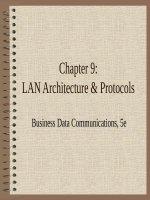Business data communications 5e by stallings chapter 05
Bạn đang xem bản rút gọn của tài liệu. Xem và tải ngay bản đầy đủ của tài liệu tại đây (151.22 KB, 40 trang )
Chapter 5: TCP/IP and OSI
Business Data Communications, 5e
What is a Protocol?
• Allows entities (i.e. application programs) from
different systems to communicate
• Shared conventions for communicating
information are called protocols
• Includes syntax, semantics, and timing
Why Use Protocol Architecture?
• Data communications requires complex
procedures
– Sender identifies data path/receiver
– Systems negotiate preparedness
– Applications negotiate preparedness
– Translation of file formats
• For all tasks to occur, high level of cooperation is
required
Modular Approach
• Breaks complex tasks into subtasks
• Each module handles specific subset of tasks
• Communication occurs
– between different modules on the same system
– between similar modules on different systems
Advantages of Modularity
• Easier application development
• Network can change without all programs being
modified
Three-Layer Model
• Distributed data communications involves three
primary components:
– Networks
– Computers
– Applications
• Three corresponding layers
– Network access layer
– Transport layer
– Application layer
Network Access Layer
• Concerned with exchange of data between
computer and network
• Includes addressing, routing, prioritizing, etc
• Different networks require different software at
this layer
• Example: X.25 standard for network access
procedures on packet-switching networks
Transport Layer
• Concerned with reliable transfer of information
between applications
• Independent of the nature of the application
• Includes aspects like flow control and error
checking
Application Layer
• Logic needed to support various applications
• Each type of application (file transfer, remote
access) requires different software on this layer
Addressing
• Each computer on a network requires a unique
address on that network
• Each application requires a unique address within
the computer to allow support for multiple
applications (service access points, or SAP)
Data Transmission
• Application layer creates data block
• Transport layer appends header to create PDU
(protocol data unit)
– Destination SAP, Sequence #, Error-Detection Code
• Network layer appends another header
– Destination computer, facilities (e.g. “priority”)
• See figure 4.5 in the book
Simplified Architecture
Protocol Architecture Operation
Standardized Protocol
Architectures
• Vendors like standards because they make their
products more marketable
• Customers like standards because they enable
products from different vendors to interoperate
• Two protocol standards are well-known:
– TCP/IP: widely implemented
– OSI: less used, but widely known and still useful for
modeling/conceptualizing
TCP/IP
• Transmission Control
Protocol/Internet
Protocol
• Developed by
DARPA
• No official protocol
standard
• Identifies 5 Layers
– Application
– Host-to-Host
(transport)
– Internet
– Network Access
– Physical
TCP/IP Physical Layer
• Physical interface between a DTE (e.g. computer
or terminal) and a transmission medium
• Specifies:
– Characteristics of medium
– Nature of signals
– Data rate
TCP/IP Network Access
• Exchange of data between systems on a shared
network
• Utilizes address of host and destination
• Can also prioritize transmission
• Software at this layer depends on network (e.g.
X.25 vs. Ethernet)
• Segregation means that no other software needs
to be concerned about net specifics
TCP/IP Internet Layer
• An Internet is an interconnection of two or more
networks
• Internet layer handles tasks similar to network
access layer, but between networks rather than
between nodes on a network
• Uses IP for addressing and routing across
networks
• Implemented in workstations and routers
TCP/IP Transport Layer
• Also called host-to-host layer
• Reliable exchange of data between applications
• Uses TCP protocols for transmission
TCP/IP Application Layer
• Logic needed to support variety of applications
• Separate module supports each type of
application (e.g. file transfer)
TCP & UDP
• Most TCP/IP applications use TCP for transport
layer
• TCP provides a connection (logical association)
between two entities to regulate flow check errors
• UDP (User Datagram Protocol) does not maintain
a connection, and therefore does not guarantee
delivery, preserve sequences, or protect against
duplication
IP and IPv6
• IP provides for 32-bit source and destination
addresses
• IPv6 (1996 standard) provides for 128-bit
addresses
• Migraqtion to IPv6 will be a very slow process
TCP/IP Applications
• SMTP (Simple Mail Transfer Protocol)
– Basic e-mail facility, transferring messages among
hosts
• FTP (File Transfer Protocol)
– Sends files from one system to another on user
command
• Telnet
– Remote login capability, allowing a user to emulate a
terminal on the remote system
Internetworking
• Interconnected networks, usually implies TCP/IP
• Can appear to users as a single large network
• The global Internet is the largest example, but
intranets and extranets are also examples
Routers
• Equipment used to interconnect independent
networks
• Several essential functions
– Provide a link between networks
– Provide routing and delivery of data between
processes on systems from different networks
– Provide the above functions without requiring
modification of the attached networks









